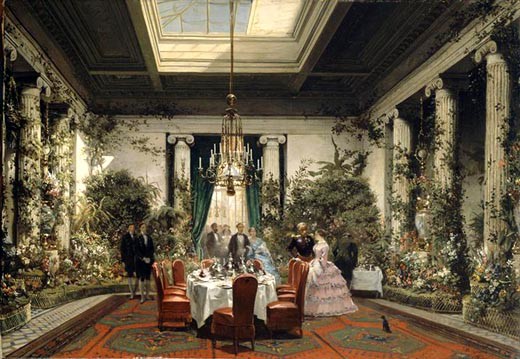Princess Mathilde (1820-1904) was the daughter of King Jerome, and was set to marry her cousin, Louis-Napoleon Bonaparte (the future Napoleon III) until the Strasbourg attempted coup d'état put an end to their engagement. Her later marriage to Prince Demidov also proved to be unsuccessful and unhappy, and their separation in 1847 was authorised by personal decision of Tsar Nicholas I. Mathilde was independent, intelligent and gifted, and was frequently seen in public during the Second Empire. During her stormy marriage to Demidov, she took as her lover Count van Nieuwerkerke, the surintendant des Beaux-Arts, whom she joined in Paris after leaving her Russian husband. In 1852, Napoleon III granted her a townhouse at 24, rue de Courcelles, in Paris. The property served as a base for Mathilde's famous literary and artistic salon which featured such celebrities of the day as the Goncourts, Flaubert, Sainte-Beuve, Théophile Gauthier, the sculptor Carpeaux and the painters Hébert, Baudry and the Giraud brothers.
Eugène Giraud (1806-1881) was introduced to Mathilde in 1847, and it was while a student of his that Mathilde, a passionate and gifted watercolour artist, exhibited some of her own works in 1859 and 1867. Initiated into the princess's private circle by his brother, Charles Giraud became in his own right a common fixture at 24 rue de Courcelles. A number of interior scenes of the townhouse, painted by Giraud, are unique in that they capture the ambiance and surroundings of Mathilde's residence and salon. They also serve to enlighten us as to the history of tastes, fashions and the decorative arts during the Second Empire. In 1854, Giraud painted the princess's “dining room”; more accurately, it depicts the winter garden in which an oval table has been set for ten (a watercolour hanging in the Musée des Arts décoratifs depicts the “actual” dining room). The shape of the room evokes an atrium from antiquity, as well as being reminiscent of the atrium in the Prince Napoleon's “Maison pompéienne”. The sober table settings (white tablecloth, silver cutlery similar to the Emperor's Tuileries service) are in stark contrast to the luxurious interior of the room. Unveiled at the 1855 salon, the painting was bought by Napoleon III who in turn offered it to his cousin.
Karine Huguenaud (tr. & ed. H.D.W.)
October 2009
Princess Mathilde’s dining room
Artist(s) : GIRAUD Charles

- Date :
- 1854
- Technique :
- Oil on canvas
- Dimensions :
- H = 56 cm, L = 61 cm
- Place held :
- Compiègne, musée national du château

